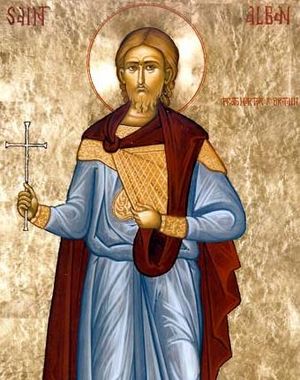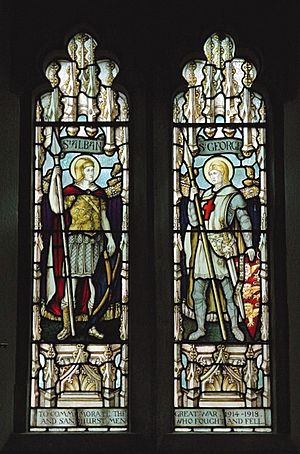Saint Alban facts for kids
Quick facts for kids SaintAlban |
|
|---|---|
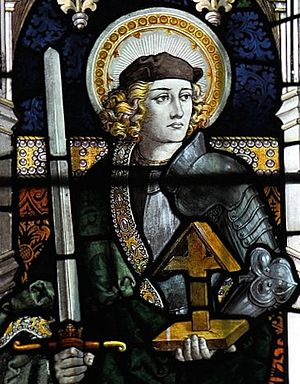 |
|
| Martyr | |
| Born | unknown Verulamium |
| Died | disputed: 22 June 209, c. 251 or 304 Holywell Hill (formerly Holmhurst Hill), St Albans |
| Venerated in | Roman Catholic Church Anglican Communion Eastern Orthodox Church |
| Major shrine | Cathedral and Abbey Church of St Alban |
| Feast | 22 June (General Roman Calendar of 1960 and Anglican Communion) 20 June (Current Roman Calendar) |
| Attributes | Soldier with a very large cross and a sword |
| Patronage | converts, refugees, torture victims |
Saint Alban is known as the first recorded British Christian martyr. This means he was the very first person in Britain to die for his Christian faith. He is one of three early martyrs from Roman Britain. The others are Saints Julius and Aaron. Alban is believed to have been beheaded in Verulamium (which is now St Albans) a long time ago. People have honored him there for many centuries.
Contents
The Story of Saint Alban
Alban lived in Roman Britain. We don't know much about his early life or how wealthy he was. The most famous story about him comes from a book by Bede called Ecclesiastical History of the English People.
How Alban Became a Christian
During the 3rd or 4th century, Christians faced harsh treatment. Alban lived in Verulamium. One day, he met a Christian priest who was running away from people who wanted to harm him. Alban bravely offered the priest a safe place to stay in his home.
The priest, who was later called Amphibalus, spent his days praying. Alban was very impressed by the priest's strong faith. He started to copy the priest and soon became a Christian himself.
Alban's Brave Choice
Word got out that Alban was hiding the priest. An important leader ordered Roman soldiers to search Alban's house. When the soldiers came to arrest the priest, Alban did something amazing. He put on the priest's cloak and clothes. Then, he presented himself to the soldiers in place of his guest.
Facing the Judge
Alban was brought before a judge. The judge was angry that Alban had helped a Christian. He said Alban would suffer the same punishments meant for the priest. This would happen unless Alban agreed to worship the Roman gods.
Alban refused to give up his new Christian faith. The judge ordered him to be whipped. He thought this would make Alban change his mind. But Alban bravely endured the pain. He even seemed happy during the torture. When the judge saw that Alban's faith was strong, he ordered Alban to be beheaded.
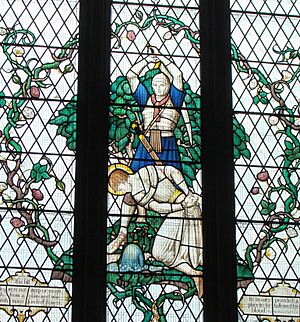
Miracles on the Way to Execution
Alban was led away to be executed. They came to a fast-flowing river, probably the River Ver. There was a bridge, but many people had gathered to watch. The bridge was so crowded that the execution party couldn't cross.
Alban wanted to reach his martyrdom quickly. He looked up to heaven, and the river miraculously dried up! This allowed Alban and his captors to walk across on dry land. The executioner was so amazed by this miracle that he dropped his sword. He fell at Alban's feet and asked to either die with Alban or be executed instead of him.
The Final Moments
The other executioners hesitated. Meanwhile, Alban and his captors walked about 500 paces to a beautiful, flower-covered hill. This hill overlooked a lovely plain. It was a perfect place, Bede wrote, to be made holy by a martyr's blood.
When Alban reached the top of the hill, he felt thirsty. He prayed to God for water. Immediately, a spring of water appeared at his feet. It was there that Alban was beheaded. The first Roman soldier, who had been converted by the miracle, was also beheaded for refusing to execute Alban.
Right after the second executioner delivered the fatal blow, his eyes popped out of his head. They fell to the ground with Alban's head. This meant the executioner could not enjoy Alban's death. Later stories say that where Alban's head stopped rolling, a well sprang up.
When the judge heard about these amazing events, he was astonished. He ordered that no more Christians should be harmed. He began to honor Saint Alban's death.
Today, St Albans Cathedral stands near the place where Alban is believed to have died. There is also a well at the bottom of Holywell Hill.
Questions About Saint Alban
Historians and experts have discussed some parts of Saint Alban's story.
When Did Alban Die?
The exact year Alban was executed is not known for sure. Different sources suggest dates between 209 and 313 AD.
The Anglo-Saxon Chronicle says 283 AD. But Bede places it around 305 AD. This was when Roman emperors first made laws against Christians. It was before 313 AD, when emperors Constantine I and Licinius allowed Christians to worship freely.
Where Was Alban Executed?
It is certain that people honored Saint Alban in Verulamium. His martyrdom was also said to have happened there. However, early writings are not very clear about the exact spot. It was not until Gildas wrote his history that Alban was clearly linked to Verulamium.
Was Alban a Real Person?
We don't have any records from the time Alban lived. The main stories about him were written hundreds of years later. These stories include amazing details that might not be entirely true.
For a long time, Saint Alban was seen as a true martyr. He was considered the first martyr of Britain. More recently, some researchers have wondered if he truly existed. Some even question his date of death and his very existence.
Honoring Saint Alban
The hilltop outside Verulamium became the main place where people honored Alban. Some believe a special memorial existed there from around 300 AD. By the time Bede wrote his book around 731 AD, there was definitely a place of worship for Saint Alban in Verulamium.
The Abbey and Cathedral
Offa of Mercia built a Benedictine Abbey and monastery at the site around 793 AD. This abbey was later destroyed but rebuilt by the Normans starting in 1077. During the High Middle Ages, St Albans Abbey was the most important abbey in England.
The abbey church is now known as St Albans Cathedral. It became a cathedral in 1877. Inside, there are parts of Saint Alban's 14th-century marble shrine.
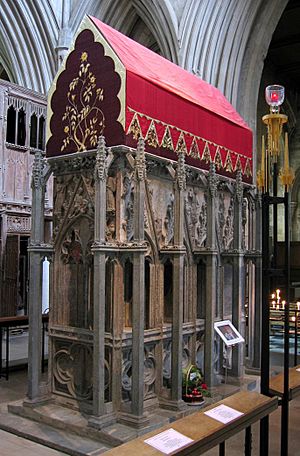
In 2002, a shoulder blade, believed to be a relic of Saint Alban, was given to St Albans Cathedral. It was placed inside his restored 13th-century shrine. This bone came from the Church of St Pantaleon in Cologne, Germany. St Pantaleon's also had a shrine to Saint Alban and has held relics believed to be his since the 10th century.
Saint Alban in Europe
Saint Alban has also been honored in other parts of Europe for a long time. This includes places like Mainz, Cologne, and Basel. Sometimes, the "Saint Alban" in these places is thought to be a different person. Other times, he is identified with the British martyr.
Saint Pantaleon's Church, Cologne has relics said to be from the British martyr Alban. These relics were supposedly brought from Rome around 984 AD. Another church in Cologne was also dedicated to the British Alban from the 12th century.
Celebrating Saint Alban Today
Alban is remembered in the Church of England with a special day on 22 June. He is still honored in the Anglican, Roman Catholic, and Eastern Orthodox churches.
Every year, around his feast day, St Albans Cathedral holds the "Alban Pilgrimage." During this event, large puppets act out the story of Alban's martyrdom around the city of St Albans.
Churches and Places Named After Saint Alban
Many churches in England are dedicated to Saint Alban. These include churches in London, Hull, Southampton, Northampton, Bristol, and Birmingham. There is also a church in Earsdon Village, Northumberland, close to Bede's Holy Island.
Saint Alban is also the Patron Saint of the Liberal Catholic Church worldwide.
Outside Britain
Churches and places named after Saint Alban can be found all over the world:
- Australia: Many Anglican churches, like the Cathedral Church of St Alban the Martyr in Griffith, New South Wales. There are also places like St Albans, Victoria, a suburb of Melbourne.
- Canada: Numerous Anglican churches across different provinces, including St. Alban's Cathedral (Kenora) and St Alban's Anglican Church in Ottawa. Places like St. Alban's, Newfoundland and Labrador are also named after him.
- Denmark: The Anglican St Alban's Church in Copenhagen is the city's only Anglican church. An older church dedicated to Saint Alban in Odense was where King Canute IV of Denmark was murdered in 1086.
- France: Churches like St Alban's Anglican in Strasbourg. Many towns are also named Saint-Alban, such as Saint-Alban-Auriolles and Saint-Alban, Côtes-d'Armor.
- Germany: Saint Pantaleon's Church, Cologne holds a shrine to St Alban. Other churches like Kath. Kirche St. Alban in Mainz are also dedicated to him.
- Ghana: St. Alban Anglican Church in Tema.
- Grenada: St. Alban's Anglican Church, Mt Moritz.
- India: St. Albans CSI Anglican Church in Kottayam.
- Japan: St. Alban Church in Tochigi and Saint Alban's Anglican-Episcopal Church in Minato City.
- Kenya: ACK St. Alban's Church in Molo and ACK St. Alban Parish Makadara in Nairobi.
- Malaysia: St. Alban Anglican Church in Sarawak.
- New Zealand: St. Alban's Anglican Church in Lower Hutt and Christchurch. St Albans is also a suburb of Christchurch.
- Nigeria: St Alban's Anglican Church, Degema.
- Philippines: Saint Alban Episcopal Church in Mankayan.
- Solomon Islands: St Alban Church, Honiara.
- South Africa: St Albans Cathedral in Pretoria and many other Anglican churches. St. Alban's College is also named after him.
- Switzerland: St.-Alban-Kirche (Basel) dates back to 1083.
- United States: Many churches and places are named St. Albans. For example, a community in Queens, New York City, is named after St Albans in England. St Alban's Episcopal Church in Washington, D.C. was built in 1854. The famous Washington National Cathedral is next to it. St Albans School for Boys is also named for the saint.
See also
 In Spanish: Albano de Verulamium para niños
In Spanish: Albano de Verulamium para niños
- Catholic Church in England
- List of early Christian saints
- List of protomartyrs
- Saint Alban's Cross
- St. Alban's Church (disambiguation)
- St. Alban's Episcopal Church (disambiguation)


